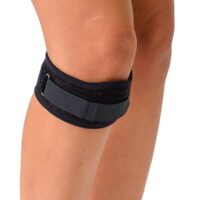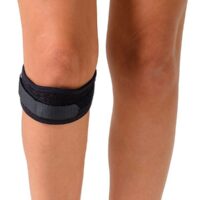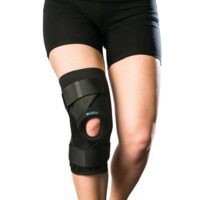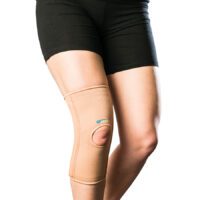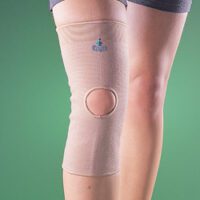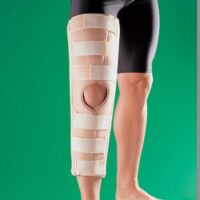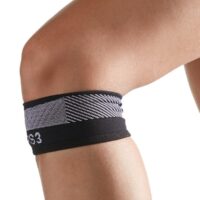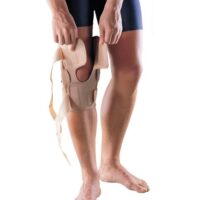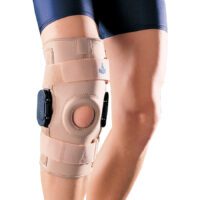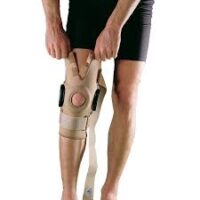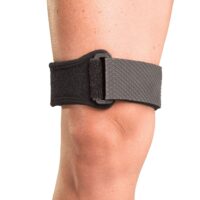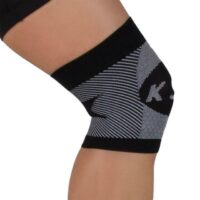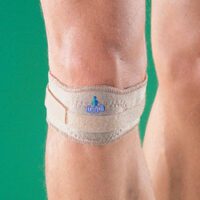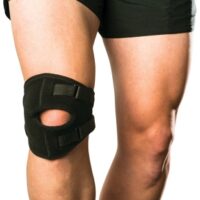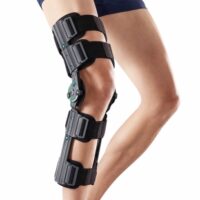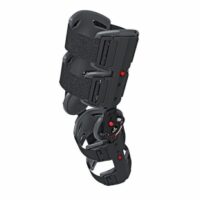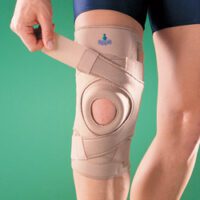ITB Syndrome
Article by John Miller

ITB Syndrome
A Runner’s Guide to Overcoming Knee Pain
ITB Syndrome, a common affliction among runners, accounts for a significant proportion of overuse injuries. This condition, often referred to as ITB Friction Syndrome or Runner’s Knee, emerges not from a single incident but rather from repeated stress. The iliotibial band, the culprit in ITB Syndrome, is a tendon that attaches to the femoral condyle—a bony prominence on the outer knee. During running, as the foot strikes the ground, the ITB slides over this bony knob, a motion that can lead to excessive friction and the characteristic pain of ITB Syndrome, particularly at the 30-degree knee bend, known as the “Impingement Zone”.
The Iliotibial Band’s Role in ITB Syndrome
The iliotibial band is a crucial structure for runners, extending from the hip down to the outer knee. It stabilises the knee during running, attaching to the Tensor Fascia Latae (TFL) and Gluteus Maximus muscles at the hip and tethering to the tibia at the knee. When the ITB is overworked, the pain of ITB Syndrome can surface, hampering a runner’s ability to train and compete.
Pinpointing the Causes of ITB Syndrome
Runners with ITB Syndrome often exhibit altered biomechanics, stemming from muscle imbalances. Weakness or tightness in key muscle groups, such as weakness of the hip rotators and core muscles or foot arch control muscles, can contribute to the condition. Factors such as improper running technique, insufficient foot arch support, and inappropriate footwear compound these biomechanical issues, while abrupt increases in running distance or excessive downhill running can exacerbate the problem.
Recognising the Symptoms of ITB Syndrome
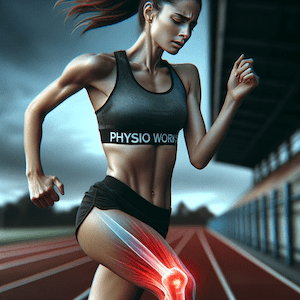
ITB Syndrome manifests as sharp or burning pain just above the knee, often worsening with continued activity. Swelling, pain during knee flexion, and a gradual onset of symptoms are hallmark signs. If these persist beyond a month, they can significantly impact athletic performance and everyday activities.
Diagnosing ITB Syndrome
A thorough examination by a physiotherapist is vital for diagnosing ITB Syndrome. They will evaluate strength, flexibility, and running mechanics. In some cases, where a more complex condition is suspected, imaging tests may be recommended, but typically, a physical assessment suffices.
Effective Treatment Strategies for ITB Syndrome
Physiotherapy stands as the cornerstone of ITB Syndrome treatment, aiming to identify and address the root causes of the condition. Treatment may include:
- Alleviating acute pain and inflammation.
- Offloading the IT band through tailored exercise regimens.
- Restoring normal joint movement.
- Strengthening the muscles around the knee, hip, and core.
- Lengthening muscles to normalise tissue tension. Foam rollers are useful.
- Enhancing balance, agility, and proprioception.
- Refining running techniques to mitigate pain and prevent recurrence.
The Role of ITB Foam Rollers
ITB Foam Rollers can be particularly beneficial, aiding in maintaining the ITB’s length and flexibility. While stretches for the ITB can be difficult to execute effectively, foam rolling offers a practical alternative.
Conclusion
For runners grappling with ITB Syndrome, understanding and addressing the condition is critical. With professional guidance from a trusted knee or running physiotherapist, the prognosis is positive. An accurate diagnosis paired with a customised treatment plan sets the stage for a successful recovery, empowering runners to return to the tracks free of pain. Remember, prevention is just as crucial as treatment—proper technique, appropriate footwear, and a well-rounded training program can keep ITB Syndrome at bay, ensuring that you stay in stride for the long run.
If your havbe been struggling with ITB syndrome, please book an appointment with your PhysioWorks physiotherapist.
Knee Pain Causes
A Comprehensive Guide
Knee pain is often a symptom of underlying issues ranging from acute injuries to systemic health conditions. Identifying knee pain causes is essential for effective treatment. This guide offers an overview of potential culprits, providing a pathway to understanding and addressing your knee discomfort.


Knee Ligament Injuries
Ligament injuries, such as ACL and PCL tears, are significant knee pain causes. They can lead to instability and severe discomfort, requiring prompt medical evaluation.
- ACL Injury
- PCL Injury
- MCL Sprain
- LCL Sprain
- Posterolateral Corner Injury
- Superior Tibiofibular Joint Sprain
- Symptoms of a Torn Ligament
- Walking with a Torn Ligament
ACL Injuries
An ACL injury is a common sports-related knee injury that can lead to long-term knee pain and require surgical intervention.
- Is Surgery Needed?
- Living Without an ACL
- Main Function of the ACL
- Untreated ACL Injury
- Symptoms of an ACL Tear
- Diagnosing an ACL Tear
- Best Surgery for ACL Tear
- Post-ACL Reconstruction Rehabilitation
Knee Meniscus Injuries
Meniscus tears, often caused by twisting or turning quickly, are prevalent knee pain causes, with treatment options varying based on severity.
Kneecap Pain
Pain in the kneecap can arise from various conditions, affecting your ability to engage in daily activities comfortably.
- Chondromalacia Patella
- Fat Pad Syndrome
- Patella Dislocation
- Patellofemoral Pain Syndrome
- Patellar Tendinopathy
- Quadriceps Tendinopathy
- Osgood Schlatter’s Disease
- Sinding Larsen Johansson Syndrome
Knee Arthritis
Arthritis is a leading cause of knee pain, particularly in older adults, with symptoms that can significantly impair quality of life.
Knee Tendon Injuries
Tendon injuries can result from overuse or sudden, high-impact activities, contributing to ongoing knee pain.
Muscle Injuries
Muscle strains and related conditions are common knee pain causes, especially among athletes and active individuals.
- Corked Thigh
- Thigh Muscle Strain
- Hamstring Strain
- ITB Syndrome
- Popliteus Syndrome
- Muscle Strain
- Muscle Cramps
- DOMS – Delayed Onset Muscle Soreness
Knee Bursitis
Inflammation of the bursae can cause significant knee pain, often requiring targeted treatment to reduce symptoms.
Children’s Knee Conditions
Young athletes can experience specific knee conditions related to growth and activity levels.
Other Knee-Related Conditions
Various other conditions can lead to knee pain, necessitating a broad understanding of potential knee pain causes.
- Baker's Cyst
- Runner’s Knee
- Reducing Knee Stress for Runners
- Plica Syndrome
- Fibromyalgia
- Stress Fracture
- Overuse Injuries
- Restless Legs Syndrome
Knee Surgery
In some cases, surgical intervention may be the best option to address certain knee pain causes effectively.
Seek Professional Advice
For tailored information regarding your knee pain, consult a healthcare professional with experience in knee conditions, such as a knee physiotherapist, sports physician or knee surgeon. They can provide a personalised assessment and treatment plan to address your specific needs.
Knee Pain Products & FAQs
A variety of products can support knee pain management. Browse our selection and read our FAQs to learn more about how to alleviate knee discomfort. More info: Knee Pain Products & FAQs
With this guide, you’re better equipped to understand the various knee pain causes and take the first step towards recovery. Remember, early intervention by a skilled physiotherapist can significantly improve your outcomes and assist in returning you to a pain-free, active lifestyle.
Knee Pain FAQs
Knee pain is a widespread issue, impacting individuals of varying ages and lifestyles. Causes range from injuries and wear and tear to conditions like arthritis. This FAQ section aims to provide insights into knee pain, covering diagnosis, ligament issues, ACL injuries, meniscal injuries, age and arthritis concerns, and pain relief methods through exercise and treatment.
Feel free to click on the questions to for deeper discussions into each topic.


Diagnosis Related
How Can I Determine If My Knee Injury Is Serious?
- Learn to assess the severity of your knee injury based on symptoms and situations.
How Can I Identify The Type Of Knee Injury I Have?
- Discover how different knee injuries manifest and what signs to look for.
When Should I Seek a Physiotherapist or Doctor for My Knee Injury?
- Find out the right time to consult professionals for your knee concerns.
Is Knee Clicking a Sign of a Serious Condition?
- Understand what knee clicking indicates about your joint health.
When Should I Consider Getting a MRI for My Knee?
- Learn about the circumstances when an MRI becomes necessary.
Why Has My Knee Suddenly Started Hurting?
- Explore potential reasons behind sudden knee pain.
Why Does My Knee Hurt On The Inner Side?
- Identify causes of inner knee pain and when to seek help.
Knee Ligament Related
What Are The Common Symptoms of a Torn Ligament in the Knee?
- Recognise the signs of a torn knee ligament.
Can I Walk With A Torn Ligament In My Knee?
- Understand the feasibility and risks of walking with a torn ligament.
ACL Related
What are the Consequences of Not Getting Surgery for an ACL Injury?
- Learn about the long-term effects of untreated ACL injuries.
What Are The Symptoms Of An ACL Tear?
- Identify the key signs of an ACL tear.
Meniscus Related
Is Surgery Necessary for a Meniscal Injury?
- Discover when surgery is essential for meniscal injuries.
Can a Torn Meniscus Heal Without Surgery?
- Find out if meniscal tears can heal naturally.
Age & Arthritis Related
At What Age Do Knee Problems Typically Begin?
- Learn about the onset age for common knee problems.
What are the Common Symptoms of Arthritis in the Knee?
- Identify arthritis symptoms in the knee.
Running Related
What are Some Ways that Runners Can Reduce Knee Stress?
- Explore methods for runners to minimise knee stress.
Knee Treatment & Exercise Related
Is Walking Good For Knee Pain?
- Understand the benefits of walking for knee pain.
What are Some Effective Ways to Relieve Knee Pain?
- Discover various methods to alleviate knee pain.
How Much Walking is Recommended for Individuals with Knee Pain?
- Learn the ideal walking duration for those with knee pain.



